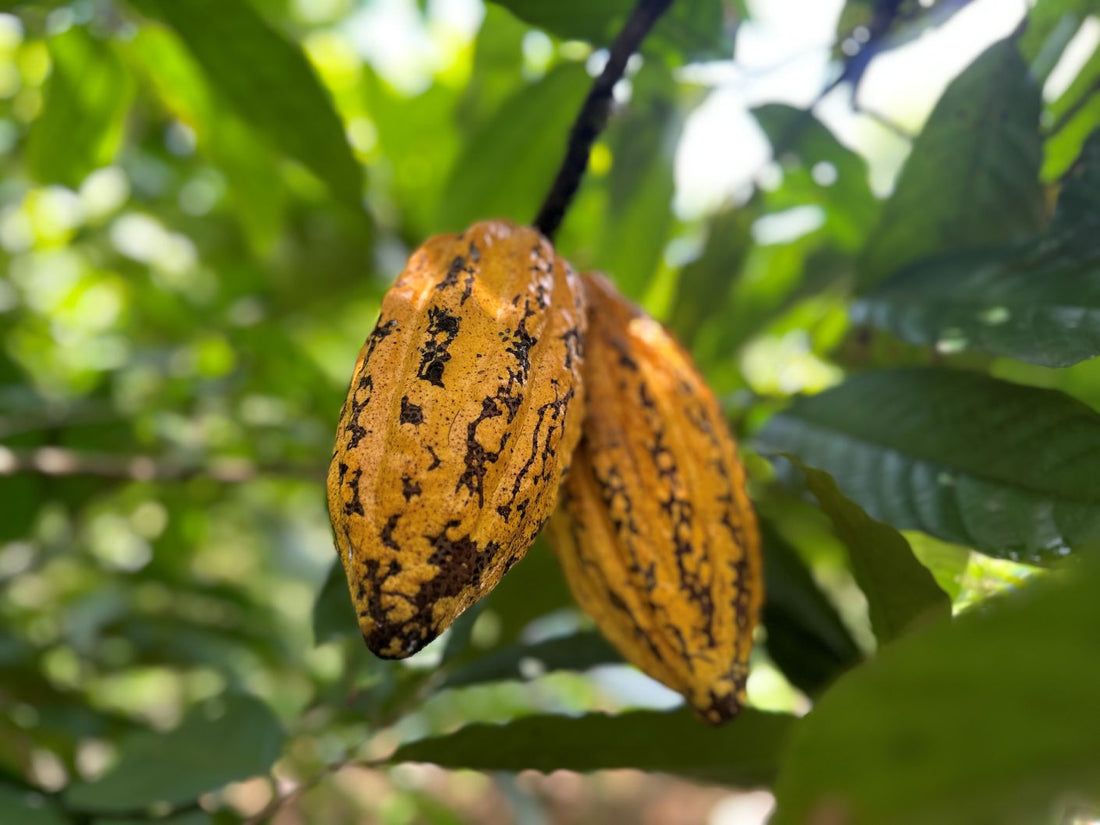
What is the Difference between Cocoa and Cacao
In the health and wellness world, the differences between cacao and cocoa are often misunderstood – but they go far beyond just spelling.
From sourcing and processing to their energetic and nutritional properties, understanding the distinction can help you make more conscious choices about what you consume, especially if you're looking for something more than just a sweet treat.
Cacao vs Cocoa: Origins, sourcing and sustainability explained
Both cacao and cocoa come from the seeds of the Theobroma cacao tree. But where and how those seeds are grown, harvested and processed make all the difference.
For Pachakuti Cacao, sourcing is a sacred process. We work hand-in-hand with farming communities in Ecuador, helping them bring high-quality cacao to a global audience. This direct-trade model ensures that the farmers are fairly compensated, and that the product itself remains pure, potent and deeply connected to its origins.
Cacao used in ceremonial raw cacao blocks are typically grown in biodiverse, sustainable environments, often using traditional farming methods. Cocoa, by contrast, is often mass-produced, with less emphasis on sustainability or community welfare. It's usually sourced through commodity markets, where traceability is limited.
How is Ceremonial Cacao made?
The biggest distinction between cacao and cocoa lies in how they're processed. Raw cacao, often sold in blocks or as ceremonial cacao, is made by cold-pressing unroasted cacao beans.
This careful method preserves the natural enzymes and retains the cacao’s rich nutrients and energetic qualities. The result is a product that not only tastes deeply of the earth but also holds profound health and spiritual benefits, making it a powerful tool in both nutrition and ritual.
Cocoa, on the other hand, is made by roasting the beans at high temperatures. While this does give it that classic chocolatey flavour many of us are familiar with, it also destroys many of the natural compounds that make cacao so revered in wellness circles.
Additionally, cocoa is often mixed with sugar, dairy and additives to make it more palatable for mass-market consumption.

The energetic and spiritual benefits of Ceremonial Cacao
One of the reasons ceremonial cacao is becoming so popular in the UK and beyond is because of its energetic profile. Cacao isn’t just a food; it’s a plant medicine.
Used for centuries in indigenous traditions across Central and South America, cacao is known for opening the heart, deepening meditation, and connecting you to yourself and others on a soul level.
The cacao used in our ceremonial cacao blocks is particularly powerful. It’s minimally processed and kept as close to its natural state as possible, making it rich in magnesium, iron, antioxidants and mood-enhancing compounds like theobromine and anandamide.
Cocoa still contains some nutrients, but in significantly lower quantities and quality; it's more of a comfort food than a healing one.
If you're looking to support your mental clarity, physical energy and emotional wellbeing, ceremonial cacao offers benefits that cocoa simply can't match.
Taste and texture of Ceremonial Cacao vs Cocoa
Because it's less processed, cacao has a more intense, earthy flavour compared to cocoa. When you make a drink using minimally processed or raw cacao, you can expect a richer, deeper chocolate experience that often carries floral, nutty or fruity notes, depending on the bean and origin.
Cocoa powder, especially the kind found in supermarket hot chocolate mixes, tends to be sweeter and less complex, and is usually paired with sugar and powdered dairy to appeal to mainstream tastes.
Why Ceremonial Cacao is gaining popularity in the Wellness Community
As more people of all ages are turning to wellness practices that support their holistic health, ceremonial cacao is fast becoming a staple. Whether it’s used in a morning ritual, a moon circle, or simply as a nourishing alternative to coffee, cacao is more than a trend - it’s a return to nature.
Pachakuti Cacao is proud to support this growing movement by offering ethically sourced, high-grade ceremonial cacao that honours both the land and the lineage it comes from. Our commitment to quality and sustainability is woven into every step, from seed to sip.

How to use Raw Cacao blocks and paste
Raw cacao blocks can be used in a variety of ways, depending on your intention. For a traditional ceremonial cacao drink, you simply shave a portion of the block and melt it with hot water. You can create your own delicious cacao drink recipe by adding spices like cinnamon, cayenne, or cardamom, or blend it with your preferred milk for a creamier texture. The key is to approach it with presence and intention.
Enjoying ceremonial cacao daily can become a grounding ritual that supports emotional balance, mental clarity and overall wellbeing.
Unlike a casual cup of cocoa, drinking ceremonial cacao is often part of a wider self-care practice. Whether you're journaling, meditating or setting goals, cacao can help create space for inner reflection and heart-centred living.
What to look for when buying high-quality Ceremonial Cacao
If you’re new to the world of ceremonial cacao, the quality of the product you choose matters. Look for cacao that is organic, ethically sourced and ideally produced in small batches.
Pachakuti Cacao ticks all these boxes. Our cacao blocks and paste are made from heirloom beans, grown by trusted farming partners in Ecuador. Each batch is carefully crafted to preserve the spirit and strength of the cacao, giving you a product you can trust and love.
Shop Ceremonial Cacao online: Minimally processed Cacao blocks
The difference between cocoa and cacao is more than just heat and processing; it’s about energy, intention and connection.
For those seeking to elevate their well-being, reconnect with themselves, or simply enjoy a more nourishing form of chocolate, ceremonial cacao offers a potent, heart-opening experience.
Shop our high-quality raw cacao blocks and pastes for use at your ceremonial circles or for everyday use.
